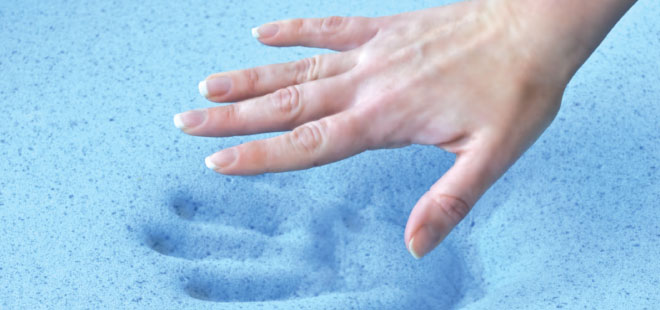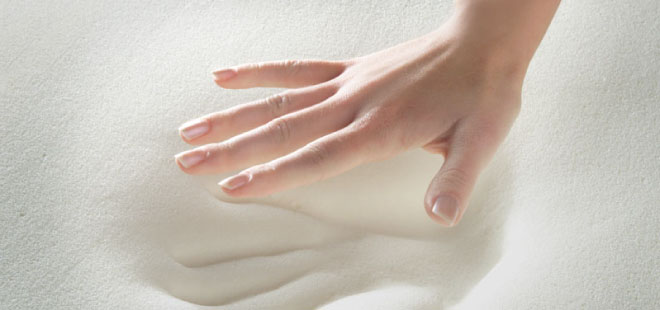Buying Guide
A good day starts with a good night’s rest, so choosing the right mattress for your sleep needs is an important decision. Gel foam and memory foam are words you will hear and read about a lot when mattress shopping, but what are the differences? In this article we will define and compare the two to help make mattress shopping easier.
Which foam is best for you? Let us first dive into the benefits you receive as a sleeper from Gel Foam vs. Memory Foam.
Why Choose Gel Foam?
- Enhanced Cooling Properties:
Gel foam mattresses disperse heat, making them ideal for hot sleepers. - Pressure Relief:
Gel foam provides excellent support and reduces pressure points. - Motion Isolation:
Gel foam is perfect for couples because it minimizes motion transfer.

Why Choose Memory Foam?
- Conforms to Body Shape:
Memory foam contours to your body, providing personalized comfort. - Great Motion Isolation:
Memory foam reduces motion transfer like gel foam. - Lighter weight:
Memory foam mattresses are often the lightest weight mattresses which make making the bed or moving it easier for people with limited mobility.

What Is a Gel Memory Foam Mattress?
A Gel Memory Foam Mattress is like a memory foam mattress but with gel infused in the foam. This addition of gel increases cooling abilities and pressure relief.
What Is Gel Memory Foam Made Of?
Memory foam is made from polyurethane, and the gel is made from soft solid (like shoe inserts). When we add it to foam, not only does it offer excess body heat a way to escape, but it also adds density to the foam making it a more supportive material.
Gel Memory Foam Mattress: Pros and Cons
Now that we have covered the basic differences, let us go over the Pros and Cons of sleeping on a Gel Memory Foam Mattress
Pros of Gel Foam Mattresses
- Cooling Properties: When we add gel to foam, the gel works as a soft solid and creates a ‘highway’ for excess heat to escape.
- Pressure Relief: When the Gel foam is compressed (by a person laying down), all the particles of gel get pressed together and offer a higher level of pressure relief.
- Motion Isolation: Gel Memory Foam does a superior job of absorbing motion when you toss and turn so you will not disturb your sleep partner.
Cons of Gel Foam Mattresses
- Higher Cost Than Memory Foam:
Since they are made from more materials, Gel Memory Foam Mattresses tend to have a higher price point. - Heavier Weight Than Memory Foam:
With the added gel, these mattresses are heavier to move and lift.
What Is a Memory Foam Mattress?
A Memory Foam Mattress is made of a few layers of a high density foam on the bottom, with varying amounts of the contouring memory foam near the surface under the sleeper.
What Is Memory Foam Made Of?
Memory Foam is made from the synthetic material Polyurethane. It was originally designed by NASA and used in the seats to absorb g-force on the astronauts during takeoff. The original recipe has been reworked to be more durable and breathable for use in mattresses.
Now that we have covered the basics of what a Memory Foam Mattress is, let us cover the Pros vs. Cons of owning one.
Pros of Memory Foam Mattresses
- Excellent Pressure Relief:
Since Memory Foam does such a great job of contouring your body, this material does an excellent job at providing pressure relief to places like your hips and shoulders. - Great Motion Isolation:
Memory Foam absorbs shock very well, so tossing and turning will not disturb your sleep partner. - Conforms to Body Shape:
Memory foam does a superior job at contouring to every person’s individual body shape.
Cons of Memory Foam Mattresses
- Heat Retention:
Not all Memory Foam is created equal, and some less expensive models especially will be created with a closed cell design that can trap in body heat. - Can Feel Too Soft for Some Sleepers:
Memory foam is often made less dense so it can contour better, if you prefer a firmer sleep surface than you may not like the feeling of sleeping ‘in’ your mattress. - Slow Response Time:
When you do roll over, the memory foam can take a few seconds to respond and adapt to your new sleep position.
Gel Foam vs Memory Foam: Similarities
Both Provide Excellent Pressure Relief
Both memory foam and gel foam provide excellent pressure relief, and spinal alignment properties. When testing out the mattresses you are interested in, try to get a feel of which benefits you more.
Both Offer Good Motion Isolation
Both memory foam and gel foam offer great motion isolation. Both options help minimize vibrations that could cause disruptions during your sleep.
Both Contour to the Body’s Shape
Memory foam and gel foam will both contour to the body. Memory foam has a classic “hugging” feeling. Gel foam retains the contouring feeling of Memory foam but has a more responsive feel.
Both Can Be Hypoallergenic
Both Gel & Memory foams, foam structure makes it, so dust mites and other pests have a difficult time penetrating it, making them a great choice for reducing allergy symptoms.
Both Come in Various Firmness Levels
Both Gel & Memory foam come in a variety of comfort levels, while in store see which model fits your needs best!
Gel Foam vs Memory Foam: Differences
Cooling Properties (Gel Foam Has Enhanced Cooling)
Both Gel and Memory Foam offer cooling properties, while Gel foam tends to feel cooler due to it having a top layer of cooling gel that helps wick away heat.
Cost (Gel Foam Is Generally More Expensive)
Gel Memory foam generally can be more expensive while Memory Foam leans on the more economical side.
Heat Retention (Memory Foam Retains More Heat)
Memory foam mattresses have the potential to trap heat as they have closed cell structured foam which can trap heat inside. Gel Foam has a top layer of cooling gel that helps wick away heat.
Durability (Memory Foam Often Has a Longer Lifespan)
Both Gel and Memory Foam offer great longevity and have a longer lifespan than traditional mattresses. The average lifespan of a Gel or Memory foam model is 7-10 years. Be sure to clean and rotate your mattress to ensure its longevity.
Initial Feel (Gel Foam Feels Cooler to the Touch)
Gel Foam has a “cool to the touch” feeling due to the top layer of cooling gel, which helps moderate your temperature for a long night’s sleep. While Memory Foam models tend to sleep hotter, they do offer cooling mesh cover and cooling layers.
How to Choose the Right Mattress for You
Shopping for a mattress doesn’t need to be hard, try out some of our models and speak with our associates to see which models feel the best for you. Try out our SmartMatch quiz to see how you sleep!
1. Determine Your Budget
When determining a budget for a mattress, you can consider your needs, research different models, and consider the price range.
2. Identify Your Preferred Sleep Position
Your preferred sleeping position can help you determine the best mattress for you. The main body surface that makes contact with the mattress determines your sleeping position, which can be on your back, sides, or stomach.
3. Consider Firmness Level
Mattress firmness is a subjective quality that can vary from person to person. The right firmness level can help with spinal alignment, cushion sensitive areas, and provide moderate support. However, a mattress that is too soft or too firm can lead to discomfort or strain over time.
4. Check for Cooling Features if You Sleep Hot
When looking for a cooling mattress, you can consider things like the materials used, the design, and the type of mattress: there are a variety of mattress model types that can fit your needs.
5. Evaluate Motion Isolation if You Share the Bed
When searching for a mattress consider Motion Isolation and Ease of Movement so you can get a deep night’s rest.
6. Look for Hypoallergenic Materials if You Have Allergies
When looking for a hypoallergenic mattress for allergies, you can consider materials that are naturally resistant to allergens or microorganisms, such as Memory Foam, Gel Foam, Latex.
7. Test the Mattress In-Store if Possible
All of our store locations have our models on display to test out and try yourself, we also offer our SmartMatch system which can help narrow down how you sleep and recommend the best models to fit your needs.
8. Read Customer Reviews
When shopping for a mattress, be sure to read customer testimonials and reviews to see if others had similar sleep patterns and what options helped them.
9. Consider Sleep Trial Periods
Consider our Sleep Trial Period which is 120 days from the date of delivery in which if the model you have chosen is not a good fit, you can reselect a model that is for equal or greater value.
10. Research the Warranty and Return Policy
When shopping for a mattress be sure to research the Warranties and what they cover, and to check on Return Policies.
Also Read: Mattress Shopping Tips: How to Choose the Right Mattress
Find Your Mattress at BedMart
Find the perfect mattress to fit your needs at BedMart! Our expert sales associates will help guide you to finding the perfect mattress. All of our locations also offer a SmartMatch system which can assist you with seeing how you sleep, and which models may best assist with your sleep style.
Shop our mattresses here!